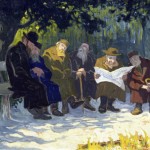Jewish Art Education is an organization “dedicated to bringing the best in the Jewish visual arts to the widest possible audience. Our mission is to educate the wider world on the contributions of the visual arts to Jewish civilization.” Earlier this year I was invited to write a guest blog for them about the Moshe Rynecki project. I did that in a piece titled, “A Window to the Past.”
More recently I was asked to write a piece about the importance and value of teaching, studying, and appreciating Jewish art. My new piece is now on their site, or you can read it here:
Appreciating Jewish Art: A personal, family tale
(Guest blog written for Jewish Art Education site. July 2013)
On my desk is a photograph of a self-portrait of my great-grandfather, dated 1931. I’ve propped it up next to my screen so that when I take a break from typing and look over at it, he’s looking back at me. When I look at him, I imagine him asking, “What are you doing?” It’s a question I frequently ask myself; the answer sometimes eludes me.
Moshe Rynecki (1881-1943), my great-grandfather, was an artist who painted scenes of the Polish Jewish community in the interwar years. He had a keen eye for exploring and documenting the daily rhythm and life of synagogue, labor, and leisure. His work is made rarer and more precious by documenting the nuances of a way of life and a place that were irrevocably torn asunder by the Nazi invasion, occupation, and the resulting Holocaust. Although I never knew my great-grandfather, since he died in a concentration camp more than 25 years before I was born, I feel as if I’ve come to know a great deal about him through his art. And as I’ve gotten older, I’ve become more and more invested in learning about my family’s heritage and legacy. A major part of that endeavor is the search for my great-grandfather’s lost and missing artwork.
Part of my effort to find the artwork springs from a personal yearning to, at least in a virtual sense, make my great-grandfather’s collection whole – to see the entire span of his work. I am, however, compelled by a larger obligation as well – to contextualize his life and work within the larger sweep of Jewish culture, history, and art.
Moshe’s dual identity as a Jew and as a member of the growing middle class in the more secular setting of Warsaw, allowed him to intimately paint aspects of Jewish life and tradition and yet to position himself as an outside observer, an ethnographer of the community. Where Moshe’s life ended and where many of his paintings still reside, the abrupt disjunction and ultimate destruction of his community, the evolution of his work, and how his brushstrokes create and enhance these tensions, these are the complex and compelling storylines that Jewish studies and art history can illuminate.
Searching for my great-grandfather’s paintings cannot be just about physically rescuing lost works or even recovering memory or understanding of those who lost their lives in the Holocaust. The lesson taught by the art itself is larger than that. Art reflects our individuality as well as the nature of our community and our times. It helps to both shape our identity and reflect upon it. Art transcends our differences and speaks to us across time and borders. It is a language we all can understand and is fundamental to the human spirit, and in that sense the lesson is universal. That was, after all, Moshe’s goal in the first place. As his son, George, wrote in his memoir about his father’s urge to paint, he said, “God gave me talent and I truly don’t believe in breaking that natural trend. I simply have to do it. If He wouldn’t want me to paint, I wouldn’t have that tremendous urge and desire to immortalize on paper or canvas what I see. I simply am a writer of sorts; instead of words, I leave my message in pictures.”
